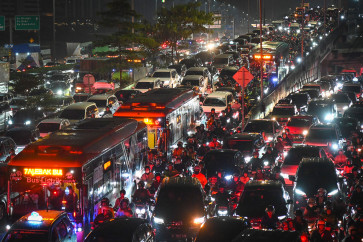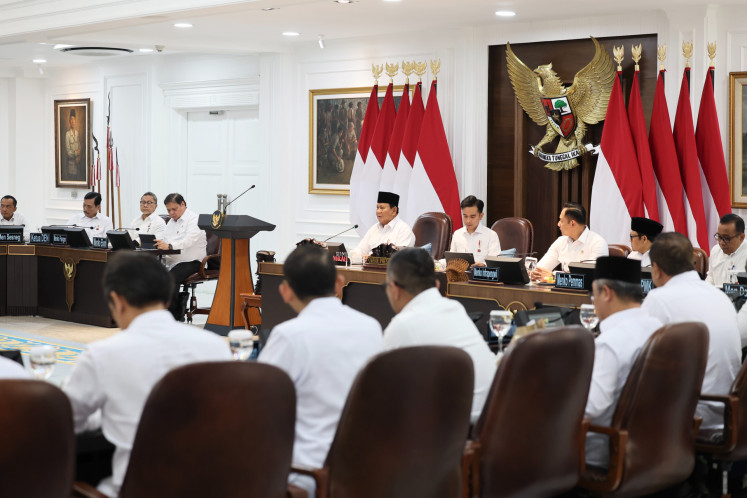Popular Reads
Top Results
Can't find what you're looking for?
View all search resultsPopular Reads
Top Results
Can't find what you're looking for?
View all search resultsAnalysis: Alternative sources of funding for infrastructure development
Infrastructure development has an important role in the economy
Change text size
Gift Premium Articles
to Anyone
I
nfrastructure development has an important role in the economy. According to the Public Works Ministry, infrastructure development has a large economic output multiplier effect. The impact of infrastructure investment on economic output is larger than its nominal investment value. The output multipler for road, bridge and port development is 1.73. That means if infrastructure investment is increased by Rp 1 billion (US$83,545), the total output of the economy will increase by Rp 1.73 billion.
Nevertheless, infrastructure development in Indonesia is still relatively low. Even though Indonesia's infrastructure quality rank in the Global Competitiveness Index (GCI) climbed from 82nd place in 2013-2014 to 72nd place in 2014-2015, Indonesia's infrastructure competitiveness remains fairly weak in comparison to the average of other ASEAN countries. Indonesia's infrastructure quality score stands at 4.2, below Singapore (6.3), Malaysia (5.6) and the average for ASEAN countries (4.4).
In terms of physical infrastructure, the total length of toll roads in Indonesia is quite short compared to other countries. At present, Indonesia's total toll road length is 918 kilometers, while Malaysia has 3,000 km and China 65,065 km. Moreover, the capacities of most national airports have been overloaded. In 2013, the ratio of passengers to capacity in Soekarno-Hatta airport was 260.9 percent and the ratio of passengers to capacity in Juanda International Airport, Surabaya was 141.7 percent.
Such relatively poor infrastructure competitiveness leads to a high cost for logistics. The proportion of Indonesia's logistical costs to its GDP is 27 percent, higher than that of Malaysia (15 percent), Japan (10.6 percent) and the United States (9.9 percent). In terms of time, the berthing time at Tanjung Priok port has reached more than six days, longer than that in both Malaysia and Thailand. In Logistics Performance Index (LPI) 2014, Indonesia ranked 53rd out of 160 countries.
The scores of customs, international shipments and infrastructure are relatively low in national logistics performance.
The government has endeavoured to accelerate infrastructure development by the MP3EI (Master Plan for the Acceleration and Expansion of Indonesian Economic Development) since 2011. Nonetheless, MP3EI has yet to be realized in an optimal manner.
The realization of MP3EI from 2011 to the first half of 2014 had reached Rp 854 trillion or 47.4 percent of the 2011-2014 target of Rp 1,803 trillion.
The largest contribution of MP3EI financing sources came from the private sector at 37.9 percent, with state-owned enterprises (BUMN) contributing 26.2 percent. What's more, in the first semester of 2014, the realization of MP3EI reached just Rp 25 trillion or 5.4 percent of the 2014 target of Rp 467 trillion. In 2014, infrastructure development constituted the largest target (60.4 percent) in MP3EI. It is expected that the biggest sources of funding for MP3EI in 2014 will derive from the private sector (43 percent), followed by state-owned enterprises (38 percent).
In the draft National Mid-Term Development Plan (RPJMN) for 2015-2019, infrastructure requirements for this period were estimated to cost Rp 5,452 trillion. This means that for each year from 2015-2019, Indonesia needs infrastructure investment of around Rp 1,090.4 trillion, or 12 percent of GDP. Meanwhile, the ability of the Government in terms of infrastructure financing remains limited.
Based on projections of the allocation of infrastructure funding in the 2015-2019 RPJMN, infrastructure funds deriving from the APBN (state budget) and APBD (regional budgets) will amount to Rp 1,178 trillion, or about only 22 percent of infrastructure needs for the period 2015-2019. In other words, a financing gap of Rp. 4,274 trillion, or 78 percent of infrastructure requirements for 2015-2019, remains. At present, total expenditure on infrastructure in the state budget stands at 2.3 percent of GDP, lower than the average for developing countries (5.5 percent GDP) and China (8.5 percent GDP).
The active role of state-owned enterprises, the banking industry and the private sector in infrastructure financing thus acquires added importance because of the limitations of the government in this regard.
As infrastructure financing requires significant amounts of investment, alternative financing is necessary. In light of this, there is still funding potential that can be optimized by the banking industry and the government for infrastructure development.
From the perspective of the banking industry, alternative infrastructure financing can be acquired by increasing banking liquidity and capital. Increased banking liqudity can be acquired by financial inclusion. While banking capital can be increased through consolidation. There are 120 million inhabitants of Indonesia who do not yet have financial access. Were 30 percent of these 120 million people to be provided with financial access, then it is estimated that an additional 30 percent of Third Party Funds (TPF) would be generated annually.
These additional TPF could, in turn, be used to finance infrastructure development.
Furthermore, the reinforcement of banking capital through consolidation is needed anyway. The capital levels of national banks are still quite limited and below the average for ASEAN countries, thereby restricting future expansion. Meanwhile, the number of public banks in Indonesia is greater than that in Malaysia and Singapore. This would indicate that banking capital could be bolstered through consolidation in the banking sector. As banking capital increases, so does the capacity of banks to finance infrastructure development.
From the government perspective, there are still other potential avenues for infrastructure financing, one of which is through increasing debt, with the assumption that the debt in question is allocated for infrastructure spending and the deficit-to-GDP ratio is no more than 3 percent. In line with the Maastrich Treaty, the government debt-to-GDP ratio can be raised to 60 percent. Currently, in the Revised 2014 State Budget, total government debt stands at 25.6 percent of GDP. Prior to the 1998 crisis, total government debt reached 38 percent of GDP. At that time, total investment in infrastructure as a proportion of GDP was around 8 percent.
____________________
The writer is regional analyst at PT Bank Mandiri (Persero) Tbk.










